MB114 Organizational Behaviour: Impact of Ageing Workforce Essay
VerifiedAdded on 2022/09/13
|7
|1723
|36
Essay
AI Summary
This essay critically examines the impact of an ageing workforce on organizational behavior, focusing on implications such as bias towards older workers, lack of innovation, and decreased organizational performance. The essay defines the ageing workforce and organizational behavior, then delves into three key implications: biasness, the resistance to implementing innovative changes due to differing work styles between older and younger employees, and how the stagnation in personal growth among older employees can affect overall organizational performance. The essay also discusses the significance of employee motivation, communication, and conflict management within the context of an ageing workforce. It suggests that organizations can mitigate these issues by providing reputable positions for older employees to mentor younger ones and by creating collaborative teams that foster mutual learning and growth. The essay concludes by emphasizing the need for organizations to align their diversified workforce to leverage the experience and behaviors of each generation, thus achieving a competitive advantage.
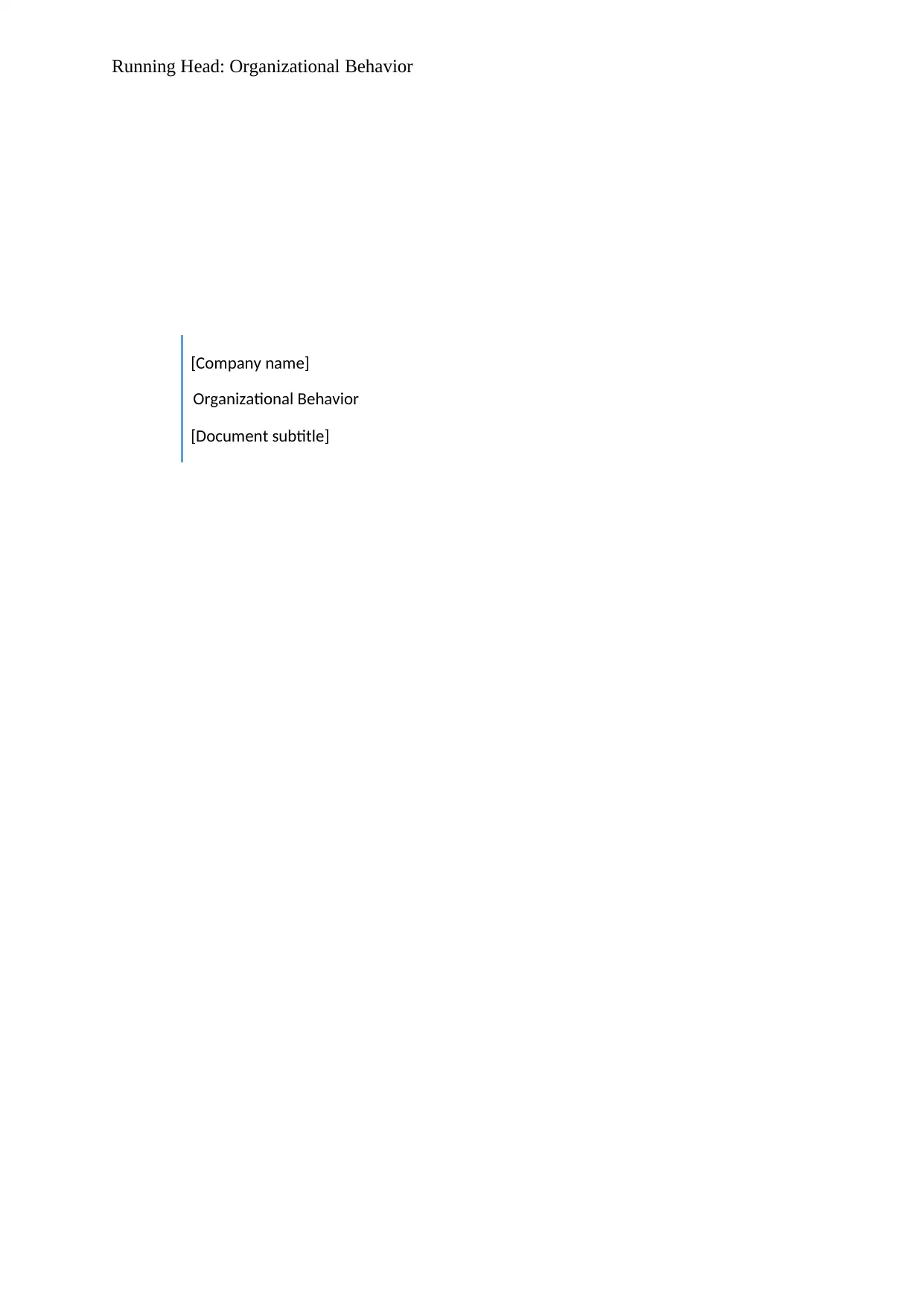
Running Head: Organizational Behavior
[Company name]
Organizational Behavior
[Document subtitle]
[Company name]
Organizational Behavior
[Document subtitle]
Paraphrase This Document
Need a fresh take? Get an instant paraphrase of this document with our AI Paraphraser
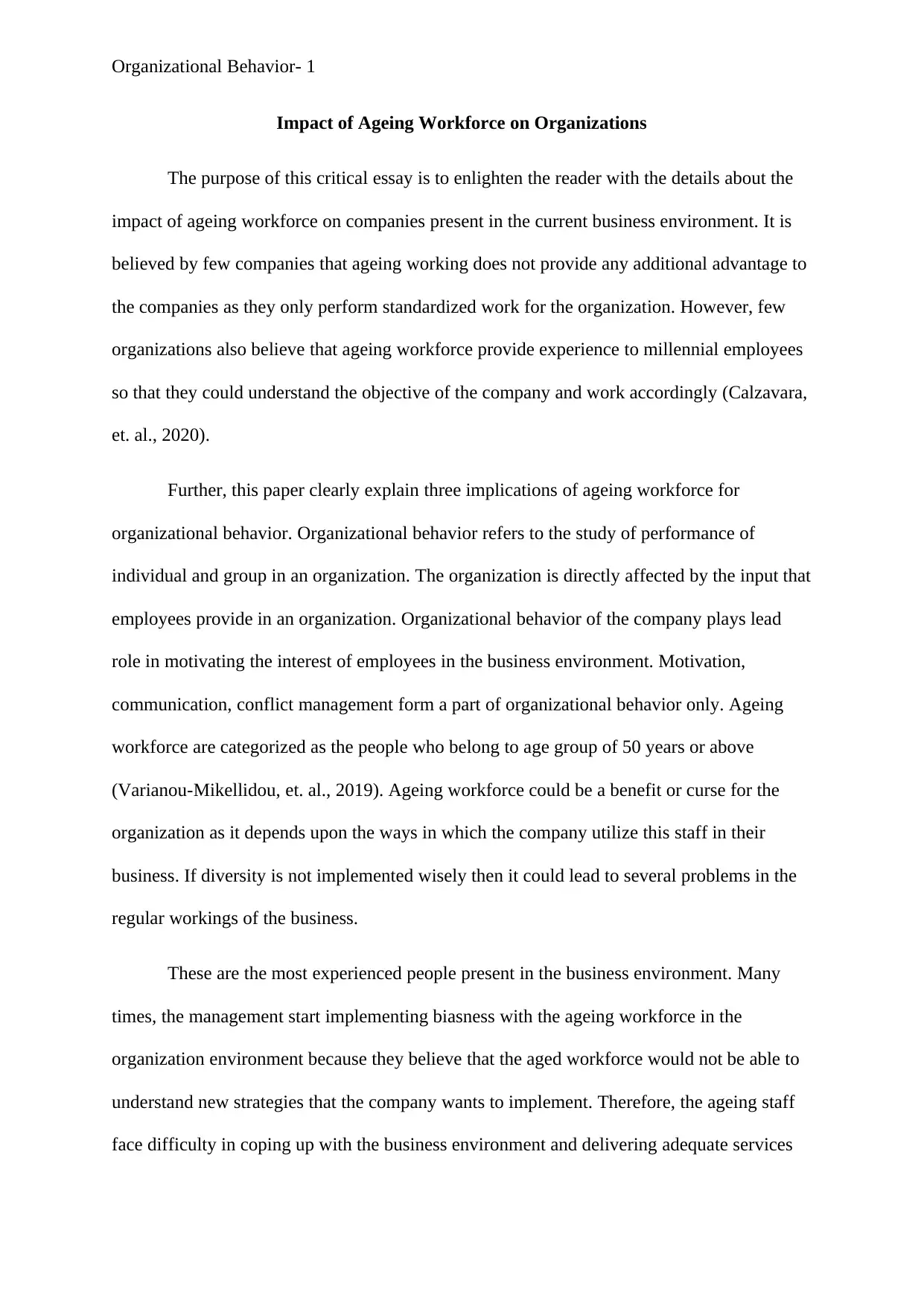
Organizational Behavior- 1
Impact of Ageing Workforce on Organizations
The purpose of this critical essay is to enlighten the reader with the details about the
impact of ageing workforce on companies present in the current business environment. It is
believed by few companies that ageing working does not provide any additional advantage to
the companies as they only perform standardized work for the organization. However, few
organizations also believe that ageing workforce provide experience to millennial employees
so that they could understand the objective of the company and work accordingly (Calzavara,
et. al., 2020).
Further, this paper clearly explain three implications of ageing workforce for
organizational behavior. Organizational behavior refers to the study of performance of
individual and group in an organization. The organization is directly affected by the input that
employees provide in an organization. Organizational behavior of the company plays lead
role in motivating the interest of employees in the business environment. Motivation,
communication, conflict management form a part of organizational behavior only. Ageing
workforce are categorized as the people who belong to age group of 50 years or above
(Varianou-Mikellidou, et. al., 2019). Ageing workforce could be a benefit or curse for the
organization as it depends upon the ways in which the company utilize this staff in their
business. If diversity is not implemented wisely then it could lead to several problems in the
regular workings of the business.
These are the most experienced people present in the business environment. Many
times, the management start implementing biasness with the ageing workforce in the
organization environment because they believe that the aged workforce would not be able to
understand new strategies that the company wants to implement. Therefore, the ageing staff
face difficulty in coping up with the business environment and delivering adequate services
Impact of Ageing Workforce on Organizations
The purpose of this critical essay is to enlighten the reader with the details about the
impact of ageing workforce on companies present in the current business environment. It is
believed by few companies that ageing working does not provide any additional advantage to
the companies as they only perform standardized work for the organization. However, few
organizations also believe that ageing workforce provide experience to millennial employees
so that they could understand the objective of the company and work accordingly (Calzavara,
et. al., 2020).
Further, this paper clearly explain three implications of ageing workforce for
organizational behavior. Organizational behavior refers to the study of performance of
individual and group in an organization. The organization is directly affected by the input that
employees provide in an organization. Organizational behavior of the company plays lead
role in motivating the interest of employees in the business environment. Motivation,
communication, conflict management form a part of organizational behavior only. Ageing
workforce are categorized as the people who belong to age group of 50 years or above
(Varianou-Mikellidou, et. al., 2019). Ageing workforce could be a benefit or curse for the
organization as it depends upon the ways in which the company utilize this staff in their
business. If diversity is not implemented wisely then it could lead to several problems in the
regular workings of the business.
These are the most experienced people present in the business environment. Many
times, the management start implementing biasness with the ageing workforce in the
organization environment because they believe that the aged workforce would not be able to
understand new strategies that the company wants to implement. Therefore, the ageing staff
face difficulty in coping up with the business environment and delivering adequate services
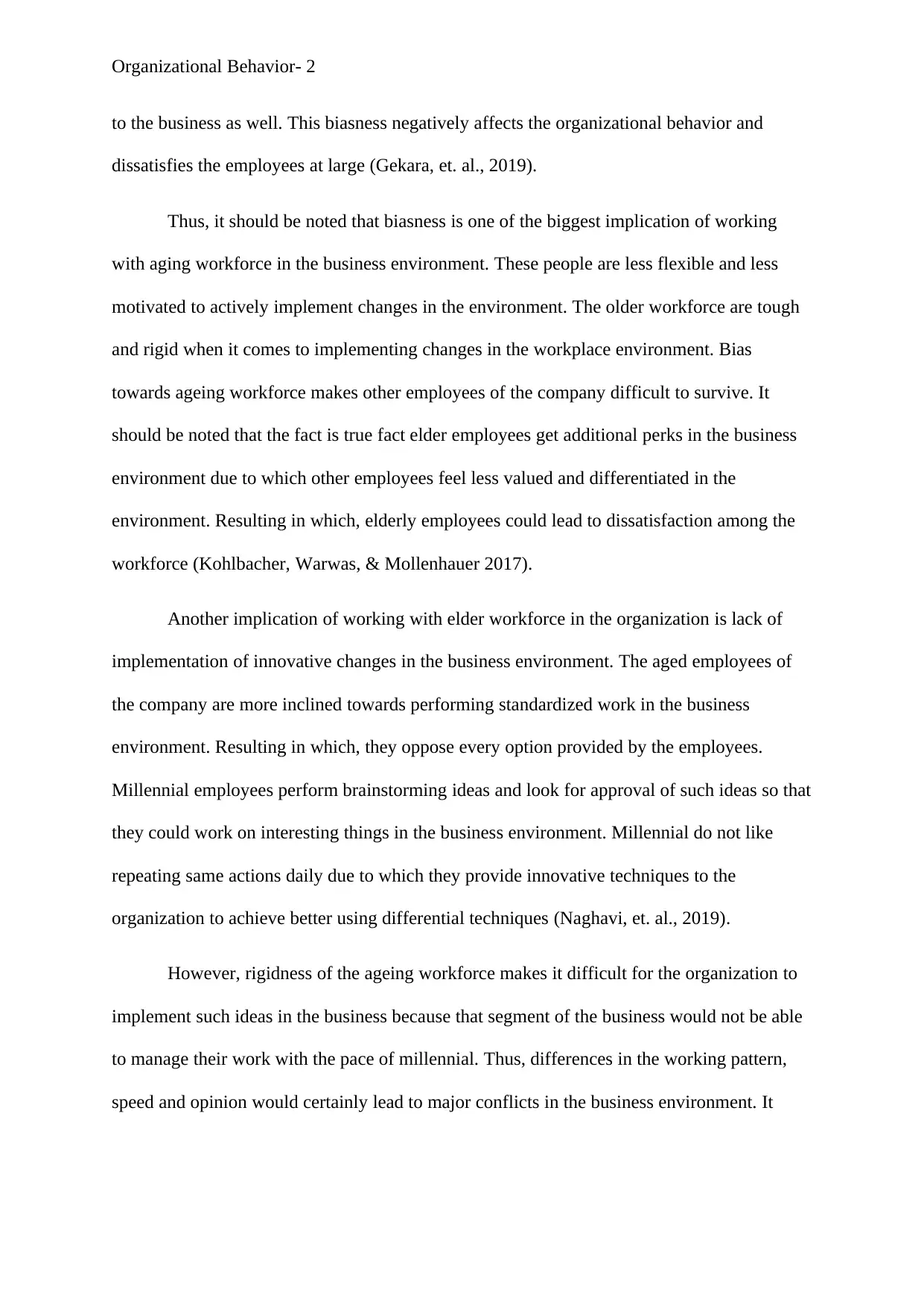
Organizational Behavior- 2
to the business as well. This biasness negatively affects the organizational behavior and
dissatisfies the employees at large (Gekara, et. al., 2019).
Thus, it should be noted that biasness is one of the biggest implication of working
with aging workforce in the business environment. These people are less flexible and less
motivated to actively implement changes in the environment. The older workforce are tough
and rigid when it comes to implementing changes in the workplace environment. Bias
towards ageing workforce makes other employees of the company difficult to survive. It
should be noted that the fact is true fact elder employees get additional perks in the business
environment due to which other employees feel less valued and differentiated in the
environment. Resulting in which, elderly employees could lead to dissatisfaction among the
workforce (Kohlbacher, Warwas, & Mollenhauer 2017).
Another implication of working with elder workforce in the organization is lack of
implementation of innovative changes in the business environment. The aged employees of
the company are more inclined towards performing standardized work in the business
environment. Resulting in which, they oppose every option provided by the employees.
Millennial employees perform brainstorming ideas and look for approval of such ideas so that
they could work on interesting things in the business environment. Millennial do not like
repeating same actions daily due to which they provide innovative techniques to the
organization to achieve better using differential techniques (Naghavi, et. al., 2019).
However, rigidness of the ageing workforce makes it difficult for the organization to
implement such ideas in the business because that segment of the business would not be able
to manage their work with the pace of millennial. Thus, differences in the working pattern,
speed and opinion would certainly lead to major conflicts in the business environment. It
to the business as well. This biasness negatively affects the organizational behavior and
dissatisfies the employees at large (Gekara, et. al., 2019).
Thus, it should be noted that biasness is one of the biggest implication of working
with aging workforce in the business environment. These people are less flexible and less
motivated to actively implement changes in the environment. The older workforce are tough
and rigid when it comes to implementing changes in the workplace environment. Bias
towards ageing workforce makes other employees of the company difficult to survive. It
should be noted that the fact is true fact elder employees get additional perks in the business
environment due to which other employees feel less valued and differentiated in the
environment. Resulting in which, elderly employees could lead to dissatisfaction among the
workforce (Kohlbacher, Warwas, & Mollenhauer 2017).
Another implication of working with elder workforce in the organization is lack of
implementation of innovative changes in the business environment. The aged employees of
the company are more inclined towards performing standardized work in the business
environment. Resulting in which, they oppose every option provided by the employees.
Millennial employees perform brainstorming ideas and look for approval of such ideas so that
they could work on interesting things in the business environment. Millennial do not like
repeating same actions daily due to which they provide innovative techniques to the
organization to achieve better using differential techniques (Naghavi, et. al., 2019).
However, rigidness of the ageing workforce makes it difficult for the organization to
implement such ideas in the business because that segment of the business would not be able
to manage their work with the pace of millennial. Thus, differences in the working pattern,
speed and opinion would certainly lead to major conflicts in the business environment. It
⊘ This is a preview!⊘
Do you want full access?
Subscribe today to unlock all pages.

Trusted by 1+ million students worldwide
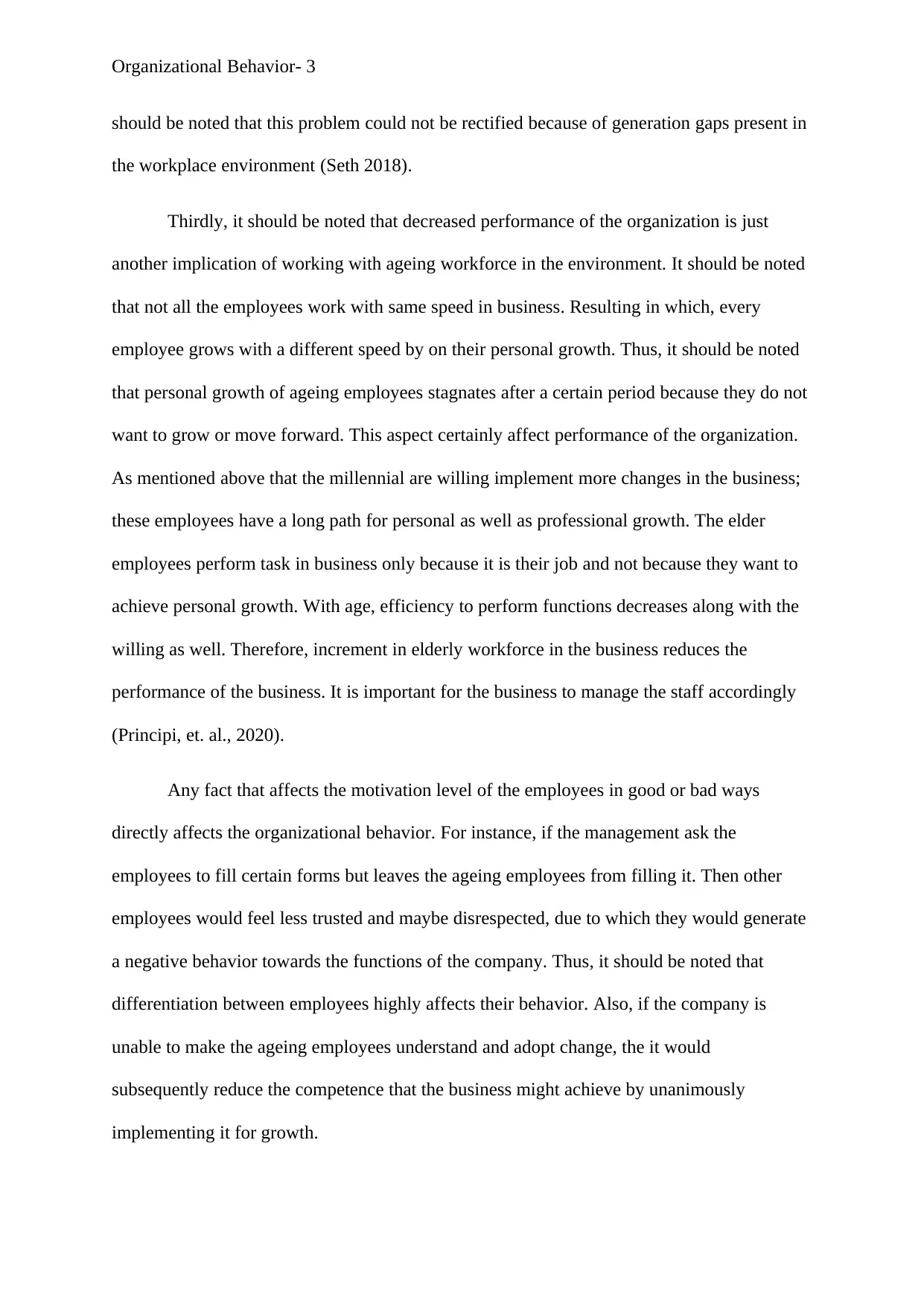
Organizational Behavior- 3
should be noted that this problem could not be rectified because of generation gaps present in
the workplace environment (Seth 2018).
Thirdly, it should be noted that decreased performance of the organization is just
another implication of working with ageing workforce in the environment. It should be noted
that not all the employees work with same speed in business. Resulting in which, every
employee grows with a different speed by on their personal growth. Thus, it should be noted
that personal growth of ageing employees stagnates after a certain period because they do not
want to grow or move forward. This aspect certainly affect performance of the organization.
As mentioned above that the millennial are willing implement more changes in the business;
these employees have a long path for personal as well as professional growth. The elder
employees perform task in business only because it is their job and not because they want to
achieve personal growth. With age, efficiency to perform functions decreases along with the
willing as well. Therefore, increment in elderly workforce in the business reduces the
performance of the business. It is important for the business to manage the staff accordingly
(Principi, et. al., 2020).
Any fact that affects the motivation level of the employees in good or bad ways
directly affects the organizational behavior. For instance, if the management ask the
employees to fill certain forms but leaves the ageing employees from filling it. Then other
employees would feel less trusted and maybe disrespected, due to which they would generate
a negative behavior towards the functions of the company. Thus, it should be noted that
differentiation between employees highly affects their behavior. Also, if the company is
unable to make the ageing employees understand and adopt change, the it would
subsequently reduce the competence that the business might achieve by unanimously
implementing it for growth.
should be noted that this problem could not be rectified because of generation gaps present in
the workplace environment (Seth 2018).
Thirdly, it should be noted that decreased performance of the organization is just
another implication of working with ageing workforce in the environment. It should be noted
that not all the employees work with same speed in business. Resulting in which, every
employee grows with a different speed by on their personal growth. Thus, it should be noted
that personal growth of ageing employees stagnates after a certain period because they do not
want to grow or move forward. This aspect certainly affect performance of the organization.
As mentioned above that the millennial are willing implement more changes in the business;
these employees have a long path for personal as well as professional growth. The elder
employees perform task in business only because it is their job and not because they want to
achieve personal growth. With age, efficiency to perform functions decreases along with the
willing as well. Therefore, increment in elderly workforce in the business reduces the
performance of the business. It is important for the business to manage the staff accordingly
(Principi, et. al., 2020).
Any fact that affects the motivation level of the employees in good or bad ways
directly affects the organizational behavior. For instance, if the management ask the
employees to fill certain forms but leaves the ageing employees from filling it. Then other
employees would feel less trusted and maybe disrespected, due to which they would generate
a negative behavior towards the functions of the company. Thus, it should be noted that
differentiation between employees highly affects their behavior. Also, if the company is
unable to make the ageing employees understand and adopt change, the it would
subsequently reduce the competence that the business might achieve by unanimously
implementing it for growth.
Paraphrase This Document
Need a fresh take? Get an instant paraphrase of this document with our AI Paraphraser
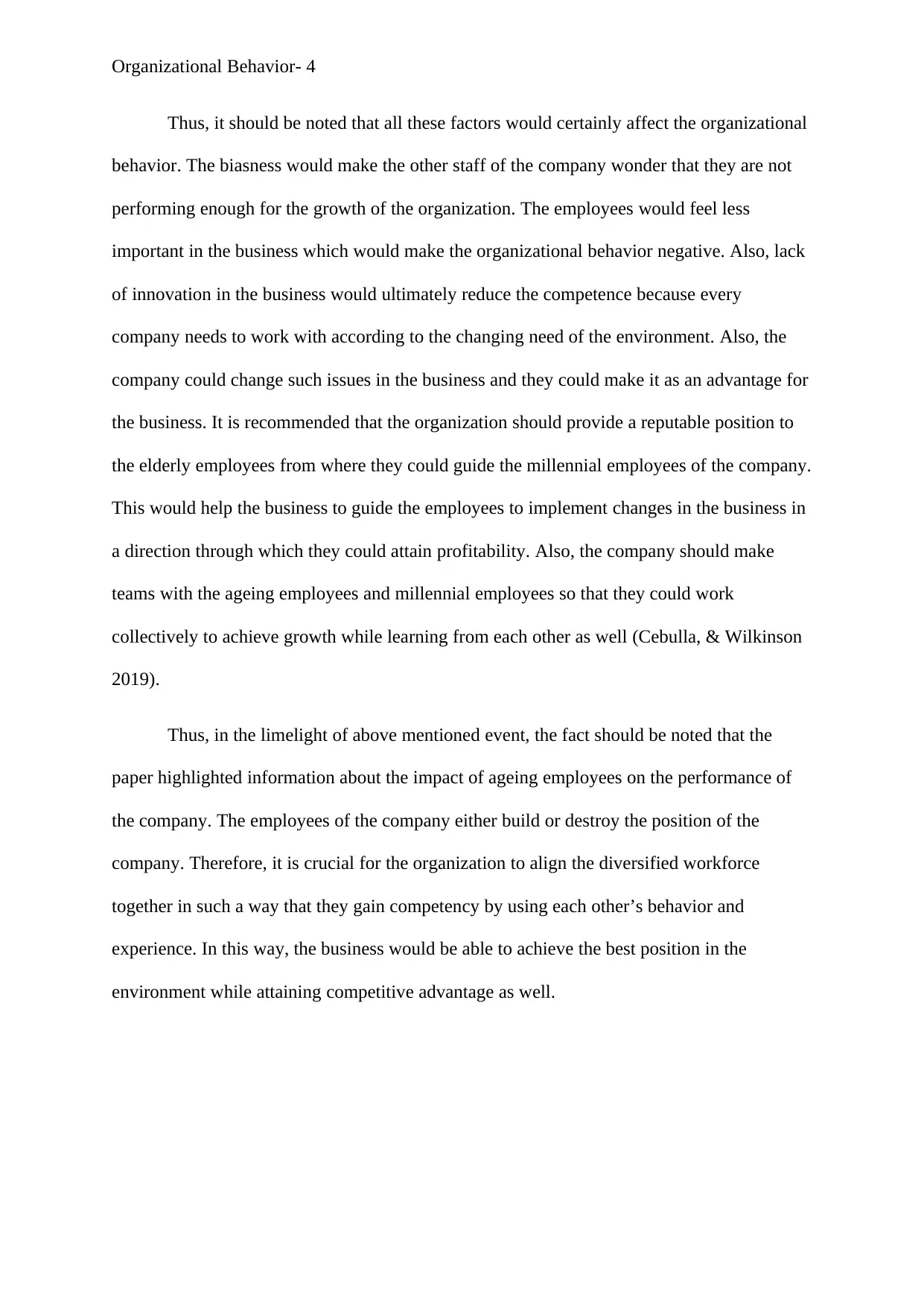
Organizational Behavior- 4
Thus, it should be noted that all these factors would certainly affect the organizational
behavior. The biasness would make the other staff of the company wonder that they are not
performing enough for the growth of the organization. The employees would feel less
important in the business which would make the organizational behavior negative. Also, lack
of innovation in the business would ultimately reduce the competence because every
company needs to work with according to the changing need of the environment. Also, the
company could change such issues in the business and they could make it as an advantage for
the business. It is recommended that the organization should provide a reputable position to
the elderly employees from where they could guide the millennial employees of the company.
This would help the business to guide the employees to implement changes in the business in
a direction through which they could attain profitability. Also, the company should make
teams with the ageing employees and millennial employees so that they could work
collectively to achieve growth while learning from each other as well (Cebulla, & Wilkinson
2019).
Thus, in the limelight of above mentioned event, the fact should be noted that the
paper highlighted information about the impact of ageing employees on the performance of
the company. The employees of the company either build or destroy the position of the
company. Therefore, it is crucial for the organization to align the diversified workforce
together in such a way that they gain competency by using each other’s behavior and
experience. In this way, the business would be able to achieve the best position in the
environment while attaining competitive advantage as well.
Thus, it should be noted that all these factors would certainly affect the organizational
behavior. The biasness would make the other staff of the company wonder that they are not
performing enough for the growth of the organization. The employees would feel less
important in the business which would make the organizational behavior negative. Also, lack
of innovation in the business would ultimately reduce the competence because every
company needs to work with according to the changing need of the environment. Also, the
company could change such issues in the business and they could make it as an advantage for
the business. It is recommended that the organization should provide a reputable position to
the elderly employees from where they could guide the millennial employees of the company.
This would help the business to guide the employees to implement changes in the business in
a direction through which they could attain profitability. Also, the company should make
teams with the ageing employees and millennial employees so that they could work
collectively to achieve growth while learning from each other as well (Cebulla, & Wilkinson
2019).
Thus, in the limelight of above mentioned event, the fact should be noted that the
paper highlighted information about the impact of ageing employees on the performance of
the company. The employees of the company either build or destroy the position of the
company. Therefore, it is crucial for the organization to align the diversified workforce
together in such a way that they gain competency by using each other’s behavior and
experience. In this way, the business would be able to achieve the best position in the
environment while attaining competitive advantage as well.
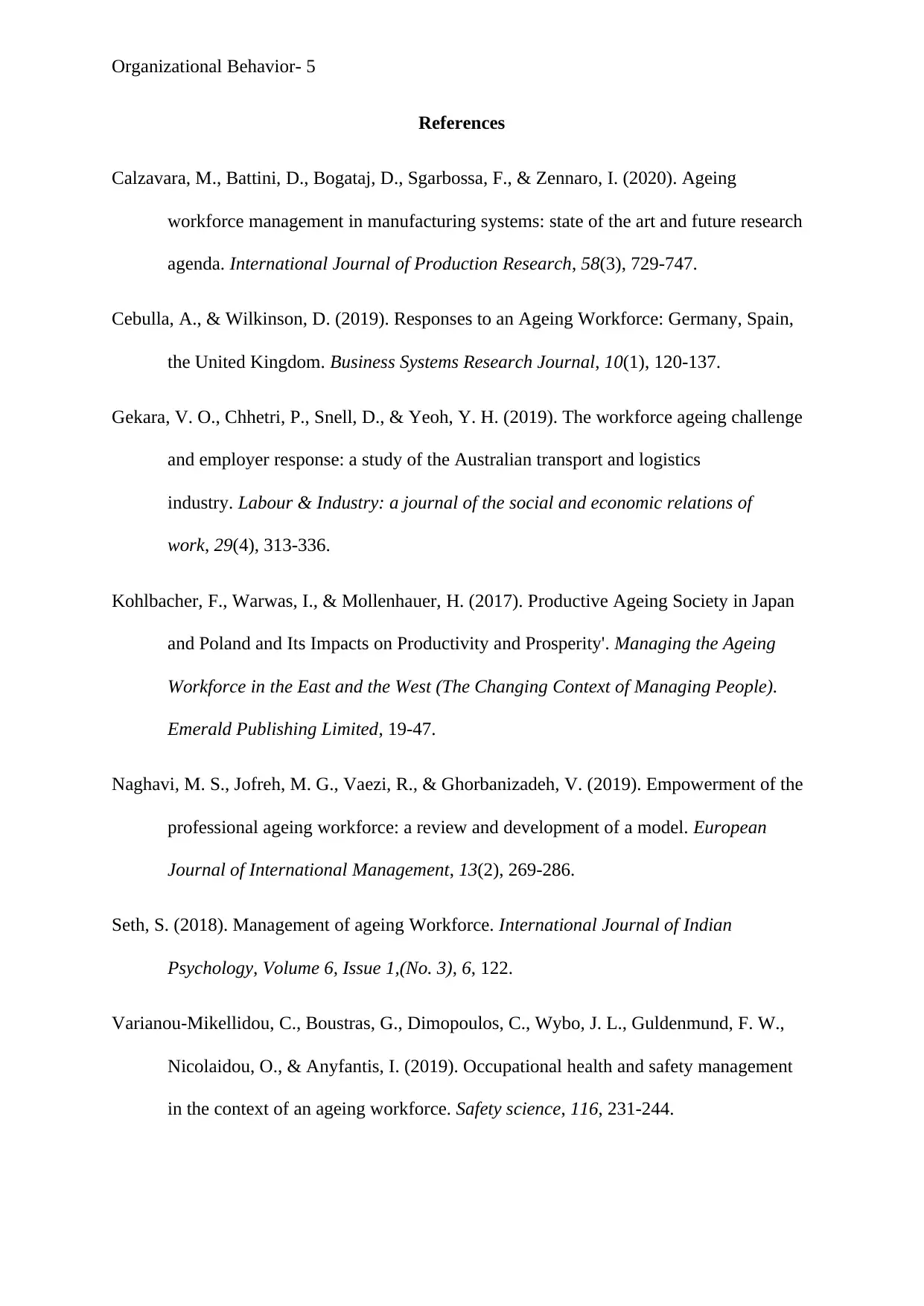
Organizational Behavior- 5
References
Calzavara, M., Battini, D., Bogataj, D., Sgarbossa, F., & Zennaro, I. (2020). Ageing
workforce management in manufacturing systems: state of the art and future research
agenda. International Journal of Production Research, 58(3), 729-747.
Cebulla, A., & Wilkinson, D. (2019). Responses to an Ageing Workforce: Germany, Spain,
the United Kingdom. Business Systems Research Journal, 10(1), 120-137.
Gekara, V. O., Chhetri, P., Snell, D., & Yeoh, Y. H. (2019). The workforce ageing challenge
and employer response: a study of the Australian transport and logistics
industry. Labour & Industry: a journal of the social and economic relations of
work, 29(4), 313-336.
Kohlbacher, F., Warwas, I., & Mollenhauer, H. (2017). Productive Ageing Society in Japan
and Poland and Its Impacts on Productivity and Prosperity'. Managing the Ageing
Workforce in the East and the West (The Changing Context of Managing People).
Emerald Publishing Limited, 19-47.
Naghavi, M. S., Jofreh, M. G., Vaezi, R., & Ghorbanizadeh, V. (2019). Empowerment of the
professional ageing workforce: a review and development of a model. European
Journal of International Management, 13(2), 269-286.
Seth, S. (2018). Management of ageing Workforce. International Journal of Indian
Psychology, Volume 6, Issue 1,(No. 3), 6, 122.
Varianou-Mikellidou, C., Boustras, G., Dimopoulos, C., Wybo, J. L., Guldenmund, F. W.,
Nicolaidou, O., & Anyfantis, I. (2019). Occupational health and safety management
in the context of an ageing workforce. Safety science, 116, 231-244.
References
Calzavara, M., Battini, D., Bogataj, D., Sgarbossa, F., & Zennaro, I. (2020). Ageing
workforce management in manufacturing systems: state of the art and future research
agenda. International Journal of Production Research, 58(3), 729-747.
Cebulla, A., & Wilkinson, D. (2019). Responses to an Ageing Workforce: Germany, Spain,
the United Kingdom. Business Systems Research Journal, 10(1), 120-137.
Gekara, V. O., Chhetri, P., Snell, D., & Yeoh, Y. H. (2019). The workforce ageing challenge
and employer response: a study of the Australian transport and logistics
industry. Labour & Industry: a journal of the social and economic relations of
work, 29(4), 313-336.
Kohlbacher, F., Warwas, I., & Mollenhauer, H. (2017). Productive Ageing Society in Japan
and Poland and Its Impacts on Productivity and Prosperity'. Managing the Ageing
Workforce in the East and the West (The Changing Context of Managing People).
Emerald Publishing Limited, 19-47.
Naghavi, M. S., Jofreh, M. G., Vaezi, R., & Ghorbanizadeh, V. (2019). Empowerment of the
professional ageing workforce: a review and development of a model. European
Journal of International Management, 13(2), 269-286.
Seth, S. (2018). Management of ageing Workforce. International Journal of Indian
Psychology, Volume 6, Issue 1,(No. 3), 6, 122.
Varianou-Mikellidou, C., Boustras, G., Dimopoulos, C., Wybo, J. L., Guldenmund, F. W.,
Nicolaidou, O., & Anyfantis, I. (2019). Occupational health and safety management
in the context of an ageing workforce. Safety science, 116, 231-244.
⊘ This is a preview!⊘
Do you want full access?
Subscribe today to unlock all pages.

Trusted by 1+ million students worldwide
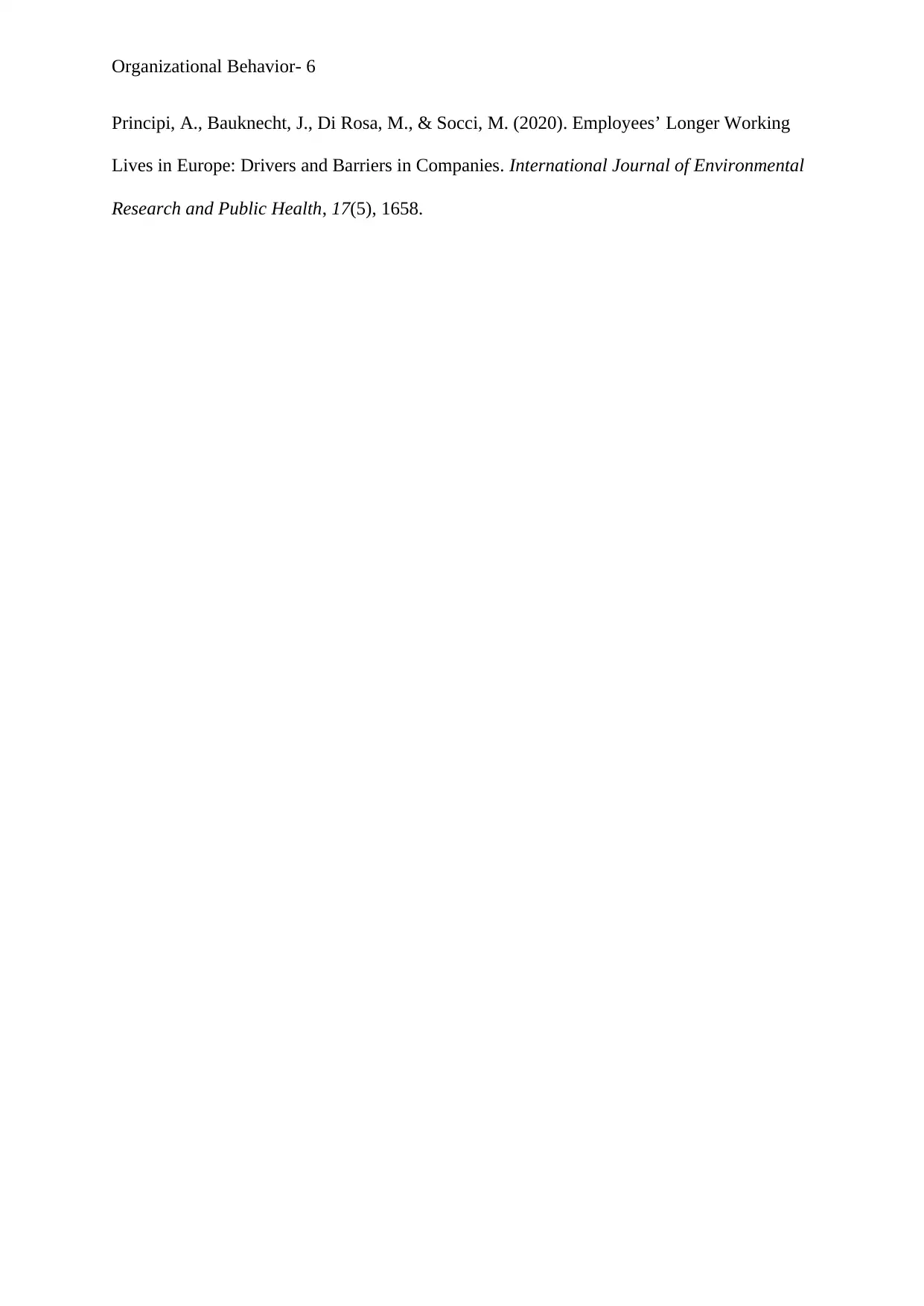
Organizational Behavior- 6
Principi, A., Bauknecht, J., Di Rosa, M., & Socci, M. (2020). Employees’ Longer Working
Lives in Europe: Drivers and Barriers in Companies. International Journal of Environmental
Research and Public Health, 17(5), 1658.
Principi, A., Bauknecht, J., Di Rosa, M., & Socci, M. (2020). Employees’ Longer Working
Lives in Europe: Drivers and Barriers in Companies. International Journal of Environmental
Research and Public Health, 17(5), 1658.
1 out of 7
Related Documents
Your All-in-One AI-Powered Toolkit for Academic Success.
+13062052269
info@desklib.com
Available 24*7 on WhatsApp / Email
![[object Object]](/_next/static/media/star-bottom.7253800d.svg)
Unlock your academic potential
Copyright © 2020–2025 A2Z Services. All Rights Reserved. Developed and managed by ZUCOL.





